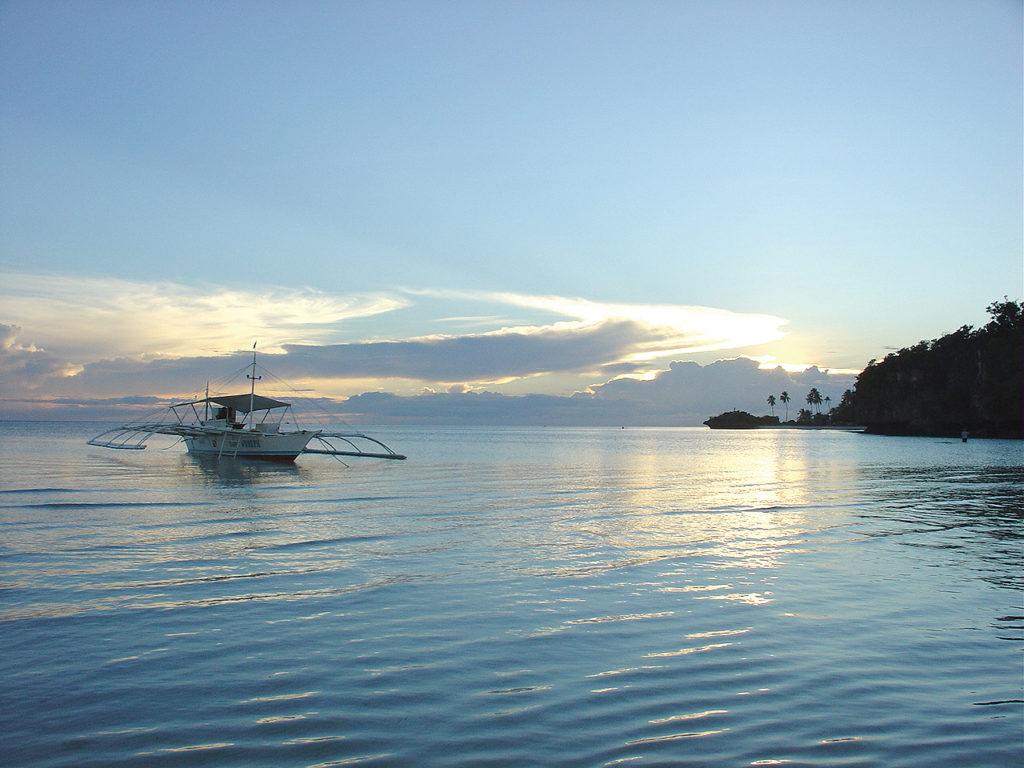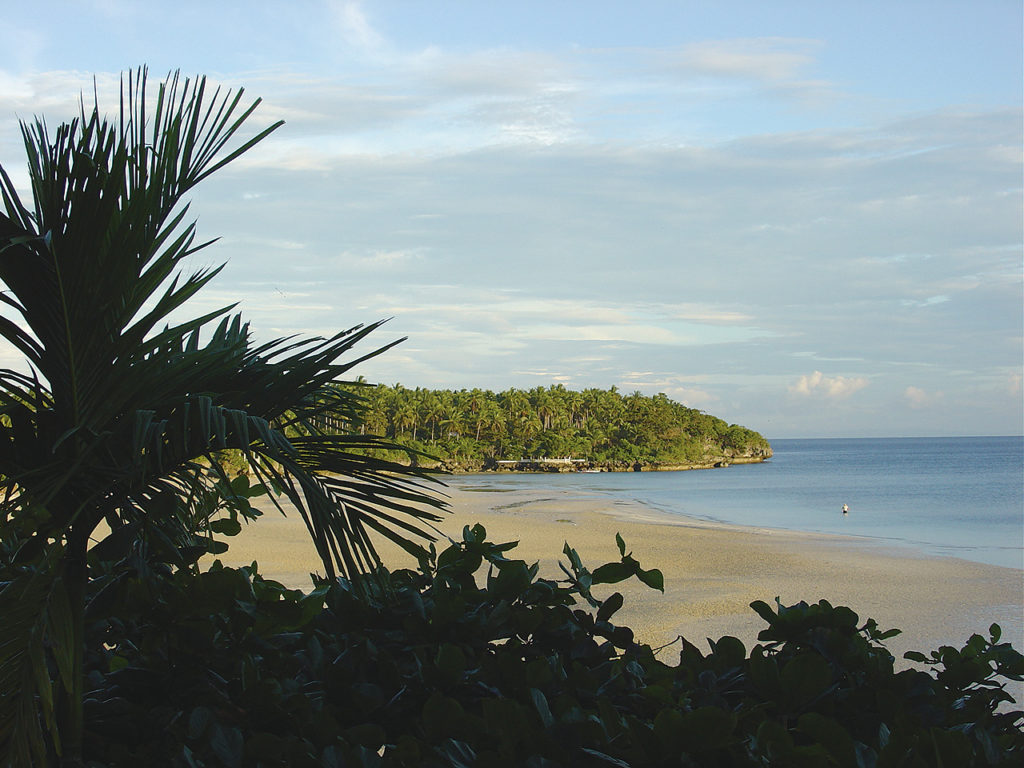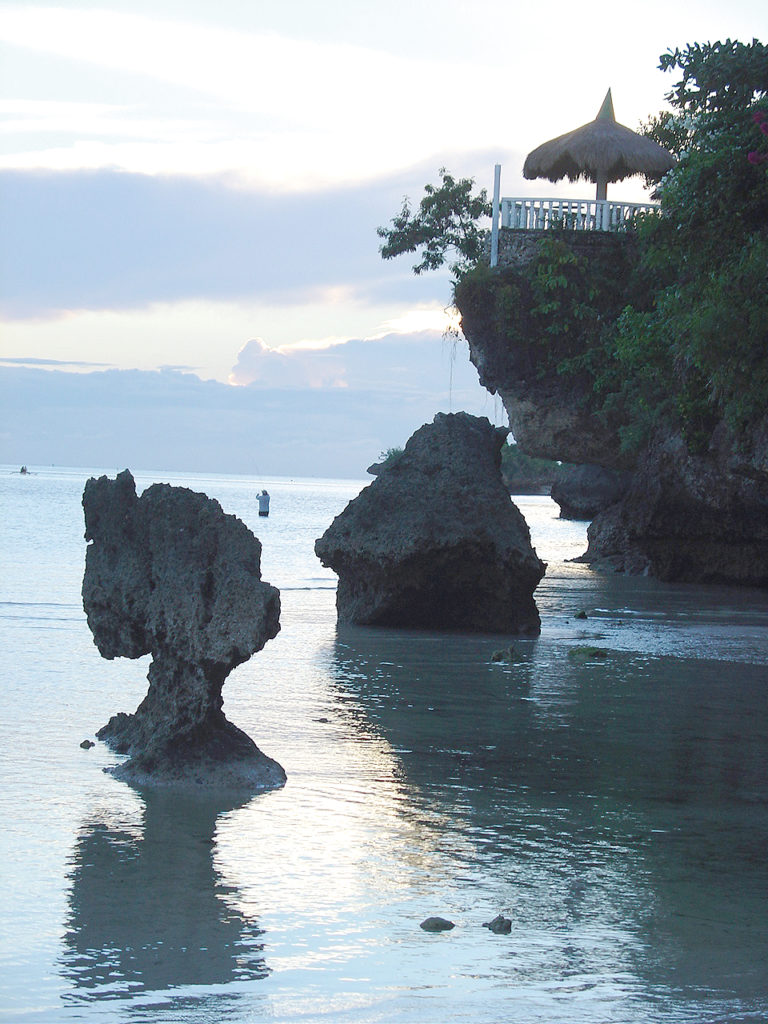After a typhoon had blown through Manila, I decided it was time to move on. My original plan was to leave Tokyo on Friday, spend Saturday in the Philippine capital and then be on my way to paradise by Sunday morn. But that was not to be. A massive storm had made its way up from the south the day I arrived and forced me to stay put in Manila three days longer than I had intended.

This was an eye-opener. I’d heard the city was an absolute dump, but I imagined this was the anti-urban bias of stoned-out hippie backpackers whose idea of Asia travel was simply reaching the nearest beach and contemplating their toenails. But the horror stories were spot on. Manila makes Bangkok look like Paris. It’s the Detroit of Southeast Asia, and I was more than ready to bid it adieu. In the mood for some peace and quiet, I carefully weighed my options.
The infamous beaches of Boracay were said to be chock-a-block with partying tourists in December. The sand and surf options of Cebu were rumored to be hit-or-miss. And the sporty island of Palawan, while appealing, seemed to be geared more toward jet skiers and scuba divers.
I wanted to slip into a mini-relaxation-coma, so I decided upon the isolated Camotes Islands.

An hour boat ride east of Cebu City, the Camotes is the sort of undeveloped Eden I thought Koh Samui, Thailand, was when I first traveled there a decade ago. The Camotes is an untouched oasis, and it’s easy to see why. It’s a chore getting there. The flight from Manila to Cebu City and the boat ride to the main port of Poro were pedestrian enough. But getting to Santiago Beach on an archaic motorbike through the jungle was another story. Not a paved road in sight, and the gravel pathway was all bump-and-grind, snaking past storybook villages and picturesque farms.
One of the most striking things about the Camotes is the plethora of churches that dot the roads. The Philippines is hands down the most Christian country in Asia, and nowhere did it seem more evident than on the back roads of the Camotes. Most locals lived in one-floor, rustic cabins; basic but by no means desolate. The churches were the most imposing buildings by far, rising high over the residents. Christmas was fast approaching, and the parishes were all decorated in the obligatory green and red.
After an hour on the motorbike, I arrived on the southernmost beach of Santiago. This was the most untouched tropical shoreline I had ever witnessed. A tiny horseshoe cove with pure white sands, where there were two miniature dinghies anchored and three kids skipping stones.

That was it. No Bob Marley music blaring. No banana boats bouncing. Nothing to do but count the waves. The only place offering accommodation here is the tiny Santiago Bay Garden and Resort. Clean, yet dirt cheap, the no-frills rooms were adequate enough. It is located right on the coast, and at night the sounds of the surf lull one to sleep.
The food at the “resort’s” small patio restaurant was standard bungalow fare, but at about 100 pesos a dish, I couldn’t complain. Besides, nobody travels to the Philippines for the cuisine. Going to the Philippines for the food is like gong to Hooters for the comfortable chairs.
Looking to do absolutely nothing, I found the right place. Lazing on the beach, swinging in a hammock, I read more books in three days than I did in four years of high school. The beaches on Santiago were pristine with no real undertow. The biggest menace here was the thousands of starfish that spread themselves out across the shallow waters of the shore. Not wanting to injure any innocent invertebrates, I tip-toed past them and made my way to deeper waters.
After three days of hardly moving, I slowly began to crave some civilization and decided to investigate the island. The Camotes is actually two separate islands (Pacijan and Poro) connected by a small bridge. The town of San Francisco, on the other end of Pacijan Island, features a lively marketplace that doesn’t see a lot of foreigners. The quaint town square has scores of multi-colored murals depicting passages from the New Testament and significant moments in Filipino history. Here I got gastronomically adventurous, deciding to challenge myself like a contestant on “Fear Factor,” I bought a Balut egg from a street vendor.
Balut is a fertilized duck egg with a partly formed embryo inside that is boiled before eaten. All the natto, fugu and basashi I had consumed in Tokyo did not prepare me for this. I was informed by the street vendor this egg had been laid 17 days ago, which is considered the perfect time for eating. As a crowd of amused locals gathered around me, I peeled it open. Inside was some sort of sad creature that resembled a slimy, albino E.T in the fetal position.

“We only go around this crazy ol’ world once,” I thought to myself. Then I ate it. It tasted like a mix between an Egg McMuffin and influenza phlegm. Supposedly it’s an aphrodisiac, but I didn’t feel too sexy after eating it. I wolfed down some local pineapple immediately after in an attempt to get the lingering taste of unborn fowl carcass out of my mouth.
That was more adventure than I had planned, so I made it back to the tranquil confines of Santiago Beach. There I enacted Phase Two of Operation: Extreme Chill Out. Over the next four days I read three more books, took more swims than Aquaman and watched four of the most gorgeous sunsets any human being has ever witnessed.
My week of rest and relaxation had come to an end and it was time to hightail it to Boracay to meet some friends and paint the town red. As much as I was looking forward to tying one on and running around in my underwear, I was sincerely saddened to say farewell to this sheltered slice of heaven.
Over the course of the next two weeks, my Filipino journey would take me hiking in Baguio, volcano viewing in Talisay and kayaking in the Lingayen Gulf. But my most unforgettable recollections will be the hushed stillness that shrouded me in the backwater beaches of the beautiful Camotes Islands.
ESSENTIAL INFO: THE CAMOTES

Getting to the Camotes from Manila is a minor task but, with some patience and planning, you can get there with relative ease. Flights from the capital to Cebu City should not be a problem at any time of the year. (Though be prepared for an onslaught of Filipinos traveling during Christmas and Easter.) Air Philippines (www.airphils.com) and Cebu Pacific (www.cebupacificair.com) are both good bets. Depending from where you are flying, try to bypass Manila altogether and fly directly to Cebu. This will start off your trip on a much less stressful note.
Once you get to Cebu City, you have two choices. Getting a ferry from Cebu City directly to the Camotes is an option. However, most of these ferries run once a day and, when I was there, they weren’t running at all. Supposedly, Palacio Shipping and Socor Shipping offer reliable passage, though the former only sails at midnight. With all the ferry sinkings that have plagued the Philippines, it might be wise to only take to the seas when you can actually see the ocean.
The other option is take a bus or taxi north to Danao and then catch a ferry. It’s a one-hour bus ride (50 pesos), but I hired a driver for about 200 pesos to avoid the hassle of the buses. Danao is a gritty fishing town, with some unspectacular beaches. Its claim to fame is being the gun producing capital of the country. If you get stuck here for the night, get a room at the respectable Intosan Resort.

Ferries to the Camotes were running irregularly when I arrived, and I had to wait a few hours longer than expected. Ask around at the main pier for information, as there were conflicting reports. The ferry ride takes about two hours and cost 50 pesos the day I traveled. Again, this is subject to change.
Once arriving at the main port of Poro, either hire or rent a motorbike. Jeepneys are few and cars non-existent. Two-wheeled transport is the only way to handle the “roads.” If you decide to rent a motorbike, cross the bridge to Pacijan Island and follow the coast down to Santiago Beach. Santiago Bay Garden and Resort is easy to find, as it is the only accommodation available here. Double rooms with a fan go for about 500 pesos.
To get back to Cebu or Danao, simply retrace your steps. Be sure to take note of the weather before getting on the ferries. I boarded the ferry back to Cebu at 5 a.m., and it was too dark to judge the weather conditions. One hour into the ocean, I realized we were heading for a storm. No fun. erry safety is not a top propriety in the Philippines, and the county has had a tragic history of oversold boats capsizing. So, keep your eyes open and trust your instincts, and you should be OK.




